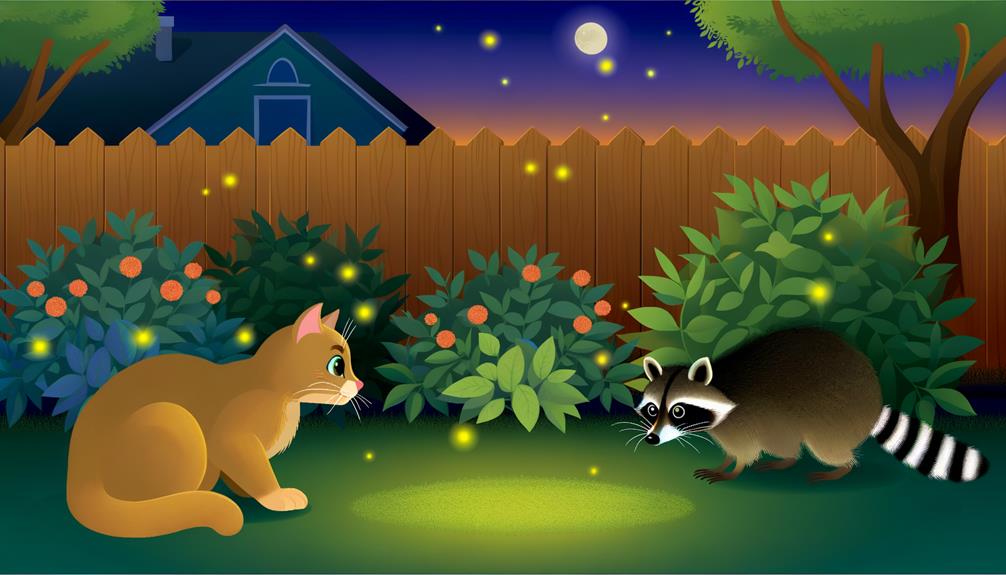How Do Cats and Raccoons Get Along in Your Backyard?
Cats and raccoons exhibit cautious coexistence, primarily due to their respective crepuscular and nocturnal behaviors. Territorial instincts and competition for food can cause conflicts, though direct skirmishes are infrequent.
Both species prioritize self-preservation; cats often maintain a safe distance from raccoons due to this reason. However, raccoons do not typically perceive cats as threats or prey.
Health risks, including disease transmission, necessitate regular vaccinations and monitored outdoor activities for cats. Adaptive social behaviors in both species have also led to documented peaceful cohabitations in various settings.
Discovering more about environmental management can further illuminate effective coexistence strategies.

Key Takeaways
- Cats and raccoons generally maintain a cautious and respectful distance from each other.
- Both species exhibit territorial instincts, but conflicts over territory are relatively infrequent.
- Competition for food resources can cause occasional skirmishes, though these are not typically aggressive.
- Raccoons can transmit diseases and parasites to cats, so health precautions are necessary.
- Cases of peaceful cohabitation have been documented, indicating possible adaptive social capacities.
Natural Habitats and Behavior
Understanding the natural habitats and behaviors of cats and raccoons is essential for analyzing their potential for peaceful cohabitation. Domestic cats (Felis catus) primarily inhabit human residences and nearby outdoor spaces, displaying crepuscular activity patterns. They show a strong preference for territorial familiarity and engage in solitary hunting behaviors.
On the other hand, raccoons (Procyon lotor) are highly adaptable omnivores, living in various environments from urban areas to dense forests. Raccoons are nocturnal, showing complex problem-solving skills and opportunistic foraging behaviors. Both species display cautious and exploratory tendencies, which can impact their interactions.
Recognizing these behavioral patterns allows for a thorough assessment of their potential for cohabitation, as it emphasizes crucial factors such as activity timing and environmental adaptability.
Territorial Instincts
Territorial instincts, deeply ingrained in both domestic cats and raccoons, play a vital role in determining the dynamics of their interactions and potential for coexistence.
Cats, Felis catus, often exhibit strong territorial behavior, marking their domain with scent glands and engaging in defensive actions when their territory is encroached upon. Similarly, Procyon lotor, raccoons, display territoriality, particularly in urban environments where space is limited.
Evidence indicates that these instinctual behaviors can lead to conflicts when their territories overlap. Research suggests that the magnitude of these conflicts is influenced by the individual animal's temperament and environmental factors.
Understanding these territorial instincts is essential for managing their interactions and fostering peaceful coexistence, especially in shared habitats such as residential areas.
Competition for Food
Competition for food between cats and raccoons often arises due to overlapping food sources, particularly in urban and suburban environments. This overlap can lead to territorial disputes, as both species vie for access to limited resources.
Such conflicts can greatly impact their dietary habits and overall well-being, necessitating careful management strategies to mitigate adverse outcomes.
Food Source Overlap
Food source overlap between cats and raccoons often leads to direct competition for available resources, impacting the dietary habits and survival strategies of both species. Cats typically rely on small mammals, birds, and commercial pet food, whereas raccoons exhibit omnivorous tendencies, consuming fruits, insects, and human refuse.
In environments where these food sources are limited, the competition intensifies, disrupting the natural foraging behaviors. Consequently, cats may face nutritional deficiencies or increased predation risks when their primary food sources are depleted by raccoons. This competition necessitates adaptive strategies, such as altered hunting patterns or reliance on alternate food sources.
Understanding these dynamics is essential for wildlife management and to mitigate potential conflicts stemming from resource scarcity in shared habitats.
Territorial Disputes
The competition for food resources not only affects dietary habits but also exacerbates territorial disputes between cats and raccoons, leading to frequent confrontations and stress-induced behavioral changes in both species.
This rivalry is particularly pronounced in urban and suburban environments where food sources are limited. Raccoons, being opportunistic feeders, often encroach upon territories habitually occupied by domestic cats, resulting in aggressive encounters. Such disputes can elevate stress levels, compromising the animals' overall health and welfare.
Evidence indicates that these confrontations are more prevalent during periods of food scarcity, underscoring the critical need for targeted interventions. Effective management strategies, including controlled feeding practices and habitat modifications, can mitigate competition and promote coexistence, thereby enhancing the well-being of both species.
Typical Interactions
Although cats and raccoons may share overlapping habitats, their typical interactions are characterized by a cautious but generally non-aggressive demeanor. Both species exhibit behaviors that prioritize self-preservation, resulting in avoidance rather than confrontation.
Studies indicate that cats often display a defensive posture, maintaining a safe distance when raccoons are present. Raccoons, known for their opportunistic feeding habits, typically do not perceive cats as a threat or prey. Observational data suggest that while occasional skirmishes can occur, particularly over food resources, these incidents are infrequent and rarely escalate to serious injury.
Safety Concerns
One primary safety concern regarding the coexistence of cats and raccoons is the potential transmission of diseases and parasites between the two species. Raccoons are known carriers of pathogens such as rabies, feline panleukopenia, and leptospirosis, which can pose serious health risks to domestic cats.
Additionally, raccoons can harbor parasites like roundworms and fleas that can easily infest cats, leading to further health complications. Veterinarians strongly recommend regular health check-ups and vaccinations for cats that may come into contact with raccoons.
Proper waste management and supervised outdoor activities for cats can also mitigate these risks. Understanding these safety concerns is essential for pet owners aiming to guarantee the well-being of their feline companions while coexisting with raccoons.
Expert Observations
Expert observations have systematically identified specific behavioral patterns between cats and raccoons, often highlighting mutual curiosity and occasional cooperative interactions.
These observations have illuminated several interaction outcomes, ranging from shared feeding territories to the establishment of social hierarchies.
Such evidence-based insights provide a foundational understanding of the dynamics at play in their interspecies relationship.
Behavioral Patterns Observed
Numerous studies and field observations have documented distinct behavioral patterns that emerge when cats and raccoons interact in shared environments. These observations provide critical insights into the dynamics of their interactions, characterized by both cooperation and competition.
The following are key behavioral patterns identified by experts:
- Territorial Displays: Both cats and raccoons exhibit territorial behaviors, often marked by scent marking and physical posturing.
- Resource Guarding: Competition for food sources can lead to aggressive behaviors, with both species displaying heightened alertness.
- Curiosity and Investigation: Initial interactions are frequently characterized by cautious curiosity, with both animals engaging in investigative behaviors.
- Play and Socialization: In some cases, particularly among younger individuals, playful interactions have been observed, indicating potential for social bonding.
Such patterns are essential for understanding these interspecies dynamics.
Interaction Outcomes Noted
Building on the documented behavioral patterns, experts have observed a range of interaction outcomes between cats and raccoons that reflect both the complexities and variabilities of their interspecies relationships. In controlled settings, raccoons have demonstrated both curiosity and territoriality, impacting the initial and ongoing dynamics with felines.
Positive interactions typically involve cautious exploration leading to mutual tolerance and occasional play behaviors. Conversely, negative outcomes are marked by aggressive posturing and resource guarding, particularly around food sources. Significantly, raccoons' nocturnal activities often disrupt the diurnal routines of cats, causing stress.
These findings, derived from longitudinal observational studies, underscore the importance of careful monitoring and environmental management when facilitating cohabitation between these species to guarantee welfare and harmony.
Real-Life Stories
Several documented cases provide compelling evidence of amicable relationships between domestic cats and raccoons in various environments. These instances, meticulously recorded, highlight scenarios where interspecies interactions result in surprisingly harmonious cohabitation.
Notable examples include:
- Residential Backyards: Observations reveal cats and raccoons frequently sharing food sources without conflict.
- Suburban Gardens: Instances of joint play behavior have been documented, indicating social compatibility.
- Animal Shelters: Reports from shelters show occasional peaceful cohabitation in shared spaces.
- Feral Colonies: In some feral cat colonies, raccoons have been known to integrate without causing disruption.
These cases suggest that under certain conditions, cats and raccoons can develop tolerance and even camaraderie, shedding light on their adaptive social capacities.
Coexistence Tips
Effective coexistence between domestic cats and raccoons necessitates strategic environmental modifications and informed behavioral management practices. Implementing secure feeding areas, using raccoon-resistant trash bins, and guaranteeing safe outdoor spaces for cats are essential. Behavioral cues from both species should be monitored to anticipate potential conflicts. Utilizing evidence-based approaches, such as controlled exposure and positive reinforcement, can facilitate a harmonious living environment.
| Area | Cat Considerations | Raccoon Considerations |
|---|---|---|
| Feeding | Elevated food stations | Raccoon-resistant containers |
| Outdoor Spaces | Secure enclosures | Limited access to attics/garages |
| Behavioral Cues | Monitor for stress or aggression | Observe for signs of territoriality |
Such measures not only guarantee safety but also promote a peaceful coexistence between species.
Conclusion
To conclude, the interactions between cats and raccoons are multifaceted, influenced by natural habitats and behavior, territorial instincts, and competition for food. Typical interactions often involve cautious cohabitation, yet safety concerns necessitate vigilance.
Expert observations underscore the variability of these encounters, while real-life stories provide anecdotal evidence of both conflict and coexistence. To promote peaceful coexistence, maintaining separate feeding areas and monitoring interactions can mitigate potential risks and foster a safer environment for both species.






